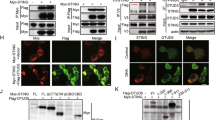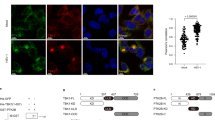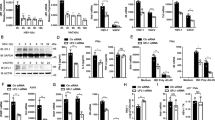Abstract
STING is a central adaptor in the innate immune response to DNA viruses. However, the manner in which STING activity is regulated remains unclear. We identified iRhom2 ('inactive rhomboid protein 2') as a positive regulator of DNA-virus-triggered induction of type I interferons. iRhom2 deficiency markedly impaired DNA-virus- and intracellular-DNA-induced signaling in cells, and iRhom2-deficient mice were more susceptible to lethal herpes simplex virus type 1 (HSV-1) infection. iRhom2 was constitutively associated with STING and acted in two distinct processes to regulate STING activity. iRhom2 recruited the translocon-associated protein TRAPβ to the STING complex to facilitate trafficking of STING from the endoplasmic reticulum to perinuclear microsomes. iRhom2 also recruited the deubiquitination enzyme EIF3S5 to maintain the stability of STING through removal of its K48-linked polyubiquitin chains. These results suggest that iRhom2 is essential for STING activity, as it regulates TRAPβ-mediated translocation and EIF3S5-mediated deubiquitination of STING.
This is a preview of subscription content, access via your institution
Access options
Subscribe to this journal
Receive 12 print issues and online access
$209.00 per year
only $17.42 per issue
Buy this article
- Purchase on Springer Link
- Instant access to full article PDF
Prices may be subject to local taxes which are calculated during checkout








Similar content being viewed by others
References
Akira, S., Uematsu, S. & Takeuchi, O. Pathogen recognition and innate immunity. Cell 124, 783–801 (2006).
Takeuchi, O. & Akira, S. Pattern recognition receptors and inflammation. Cell 140, 805–820 (2010).
Barbalat, R., Ewald, S.E., Mouchess, M.L. & Barton, G.M. Nucleic acid recognition by the innate immune system. Annu. Rev. Immunol. 29, 185–214 (2011).
Lund, J., Sato, A., Akira, S., Medzhitov, R. & Iwasaki, A. Toll-like receptor 9-mediated recognition of Herpes simplex virus-2 by plasmacytoid dendritic cells. J. Exp. Med. 198, 513–520 (2003).
Bürckstümmer, T. et al. An orthogonal proteomic-genomic screen identifies AIM2 as a cytoplasmic DNA sensor for the inflammasome. Nat. Immunol. 10, 266–272 (2009).
Takaoka, A. et al. DAI (DLM-1/ZBP1) is a cytosolic DNA sensor and an activator of innate immune response. Nature 448, 501–505 (2007).
Chiu, Y.H., Macmillan, J.B. & Chen, Z.J. RNA polymerase III detects cytosolic DNA and induces type I interferons through the RIG-I pathway. Cell 138, 576–591 (2009).
Ablasser, A. et al. RIG-I-dependent sensing of poly(dA:dT) through the induction of an RNA polymerase III-transcribed RNA intermediate. Nat. Immunol. 10, 1065–1072 (2009).
Unterholzner, L. et al. IFI16 is an innate immune sensor for intracellular DNA. Nat. Immunol. 11, 997–1004 (2010).
Zhang, Z. et al. The helicase DDX41 senses intracellular DNA mediated by the adaptor STING in dendritic cells. Nat. Immunol. 12, 959–965 (2011).
Li, Y. et al. LSm14A is a processing body-associated sensor of viral nucleic acids that initiates cellular antiviral response in the early phase of viral infection. Proc. Natl. Acad. Sci. USA 109, 11770–11775 (2012).
Paludan, S.R. & Bowie, A.G. Immune sensing of DNA. Immunity 38, 870–880 (2013).
Sun, L., Wu, J., Du, F., Chen, X. & Chen, Z.J. Cyclic GMP-AMP synthase is a cytosolic DNA sensor that activates the type I interferon pathway. Science 339, 786–791 (2013).
Li, X.D. et al. Pivotal roles of cGAS-cGAMP signaling in antiviral defense and immune adjuvant effects. Science 341, 1390–1394 (2013).
Wu, J. et al. Cyclic GMP-AMP is an endogenous second messenger in innate immune signaling by cytosolic DNA. Science 339, 826–830 (2013).
Ishikawa, H. & Barber, G.N. STING is an endoplasmic reticulum adaptor that facilitates innate immune signalling. Nature 455, 674–678 (2008).
Ishikawa, H., Ma, Z. & Barber, G.N. STING regulates intracellular DNA-mediated, type I interferon-dependent innate immunity. Nature 461, 788–792 (2009).
Zhong, B. et al. The adaptor protein MITA links virus-sensing receptors to IRF3 transcription factor activation. Immunity 29, 538–550 (2008).
Tsuchida, T. et al. The ubiquitin ligase TRIM56 regulates innate immune responses to intracellular double-stranded DNA. Immunity 33, 765–776 (2010).
Zhang, J., Hu, M.M., Wang, Y.Y. & Shu, H.B. TRIM32 protein modulates type I interferon induction and cellular antiviral response by targeting MITA/STING protein for K63-linked ubiquitination. J. Biol. Chem. 287, 28646–28655 (2012).
Wang, Q. et al. The E3 ubiquitin ligase AMFR and INSIG1 bridge the activation of TBK1 kinase by modifying the adaptor STING. Immunity 41, 919–933 (2014).
Zhong, B. et al. The ubiquitin ligase RNF5 regulates antiviral responses by mediating degradation of the adaptor protein MITA. Immunity 30, 397–407 (2009).
Qin, Y. et al. RNF26 temporally regulates virus-triggered type I interferon induction by two distinct mechanisms. PLoS Pathog. 10, e1004358 (2014).
Ahn, J., Gutman, D., Saijo, S. & Barber, G.N. STING manifests self DNA-dependent inflammatory disease. Proc. Natl. Acad. Sci. USA 109, 19386–19391 (2012).
Jeremiah, N. et al. Inherited STING-activating mutation underlies a familial inflammatory syndrome with lupus-like manifestations. J. Clin. Invest. 124, 5516–5520 (2014).
Liu, Y. et al. Activated STING in a vascular and pulmonary syndrome. N. Engl. J. Med. 371, 507–518 (2014).
Freeman, M. Rhomboid proteases and their biological functions. Annu. Rev. Genet. 42, 191–210 (2008).
Adrain, C., Zettl, M., Christova, Y., Taylor, N. & Freeman, M. Tumor necrosis factor signaling requires iRhom2 to promote trafficking and activation of TACE. Science 335, 225–228 (2012).
McIlwain, D.R. et al. iRhom2 regulation of TACE controls TNF-mediated protection against Listeria and responses to LPS. Science 335, 229–232 (2012).
Bergbold, N. & Lemberg, M.K. Emerging role of rhomboid family proteins in mammalian biology and disease. Biochim. Biophys. Acta 1828, 2840–2848 (2013).
Issuree, P.D. et al. iRHOM2 is a critical pathogenic mediator of inflammatory arthritis. J. Clin. Invest. 123, 928–932 (2013).
Prantner, D. et al. 5,6-Dimethylxanthenone-4-acetic acid (DMXAA) activates stimulator of interferon gene (STING)-dependent innate immune pathways and is regulated by mitochondrial membrane potential. J. Biol. Chem. 287, 39776–39788 (2012).
Gao, P. et al. Structure-function analysis of STING activation by c[G(2′,5′)pA(3′,5′)p] and targeting by antiviral DMXAA. Cell 154, 748–762 (2013).
Shu, H.B. & Wang, Y.Y. Adding to the STING. Immunity 41, 871–873 (2014).
Saitoh, T. et al. Atg9a controls dsDNA-driven dynamic translocation of STING and the innate immune response. Proc. Natl. Acad. Sci. USA 106, 20842–20846 (2009).
Konno, H., Konno, K. & Barber, G.N. Cyclic dinucleotides trigger ULK1 (ATG1) phosphorylation of STING to prevent sustained innate immune signaling. Cell 155, 688–698 (2013).
Acknowledgements
Supported by the Ministry of Science and Technology of China (2014CB910103 and 2012CB910201) and the National Natural Science Foundation of China (31521091 and 91429304).
Author information
Authors and Affiliations
Contributions
H.-B.S., S.L. and W.-W.L. conceived and designed the study. S.L. performed the human cDNA expression plasmid screens. W.-W.L., C.L., H.L. and Q.Y. performed the majority of experiments. H.B.S., S.L., W.-W.L., C.L., H.L. and B.Z. analyzed the data. H.-B.S. and W.-W.L. wrote the manuscript. All of the authors discussed the results and commented on the manuscript.
Corresponding author
Ethics declarations
Competing interests
The authors declare no competing financial interests.
Integrated supplementary information
Supplementary Figure 1 Generation and analysis of iRhom2-deficient mice.
(a) Schematic representation of wild-type iRhom2 locus shows its exons (boxes) and introns (lines). The iRhom2 locus was disrupted by the targeting vector and the positions of the primers for genotyping are shown. The splice acceptor (SA) sequence in the LacZ cassette interrupts the normal splicing of iRhom2 gene, resulting in the loss of iRhom2 expression.
(b) Genotyping of iRhom2 mutant mice.
(c) qPCR analysis of iRhom2 mRNA abundance in MEFs, BMDMs and BMDCs of various genotypes.
(d) Genotypes of the offsprings from the breeding of iRhom2 heterozygous mice.
(e) Cells from thymus, spleen and peripheral lympho nodes were analyzed by FACS after staining with the indicated antibodies.
Data are representative of three (b,c) or two (e) independent experiments.
Supplementary Figure 2 Effects of iRhom2 deficiency on mRNA and protein abundance of TNF.
(a) ELISA analysis of secreted IFN-β and TNF from iRhom2+/+ and iRhom2−/− MEFs un-treated or treated with LPS for 4 h.
(b) The mRNA or secreted protein of TNF in iRhom2+/+ and iRhom2−/− MEFs infected with HSV-1 for the indicated times was quantitated by qPCR (left histograph) or ELISA (right histograph) analysis respectively.
**P < 0.01 (unpaired t-test). Data are representative of three experiments with similar results (mean and s.d. in a,b).
Supplementary Figure 3 Effects of iRhom2 deficiency on cGAMP- and DMXAA-induced signaling.
(a) Immunoblot analysis of the indicated proteins in iRhom2+/+ and iRhom2−/− MEFs transfected with cGAMP for the indicated times.
(b) qPCR analysis of mRNA abundance of the indicated genes in iRhom2+/+ and iRhom2−/− MEFs treated with DMXAA for the indicated times.
*P < 0.05; **P < 0.01 (unpaired t-test). Data are representative of three experiments with similar results (mean and s.d. in b).
Supplementary Figure 4 Colocalization of iRhom2 with various components.
Confocal microscopy of HeLa cells transfected with iRhom2-Cherry and the indicated Flag-tagged components. Data are representative of three experiments with similar results. Scale bars, 20 μm.
Supplementary Figure 5 Domain-mapping analysis of the interaction between iRhom2 and TRAPβ.
HEK293 cells were transfected with the indicated plasmids before coimmunoprecipitation and immunoblot analysis were performed with the indicated antibodies. The top part shows schematic representations of iRhom2 truncations. Data are representative of three experiments with similar results.
Supplementary Figure 6 iRhom2 regulates the protein abundance and K48-linked polyubiquitination of STING.
(a) Immunoblot analysis of STING in iRhom2+/+ and iRhom2−/− BMDMs infected with HSV-1 for the indicated times.
(b) Immunoblot analysis of STING, TBK1 and iRhom2 in iRhom2-knockdown THP-1 cells infected with HSV-1 for the indicated times.
(c) qPCR analysis of STING mRNA in HEK293 cells transfected with an iRhom2-RNAi plasmid for 24 h and then selected with puromycin for 24 h.
(d) Immunoblot analysis of the indicated proteins in HEK293 cells transfected with iRhom2 for 20 h and then treated with cycloheximide for the indicated times.
(e) HEK293 cells were transfected with iRhom2, STING-Flag, and HA-Ub or its mutants as indicated for 24 h before coimmunoprecipitation and immunoblot analysis were performed with the indicated antibodies.
Data are representative of three experiments with similar results.
Supplementary Figure 7 Identification of EIF3S5 as a deubiquitinase for STING.
(a-c) HEK293 cells were transfected with the indicated plasmids for 24 h before coimmunoprecipitation and immunoblot analysis were performed with the indicated antibodies. EV, empty vector.
(d) Immunostaining showing localization of EIF3S5 (red) in HeLa cells transfected with Myc-tagged EIF3S5 and GFP-tagged Rab9, GM130 or Atg12a respectively and infected with HSV-1 for 6 h. Scale bars, 20 μm.
(e) Immunostaining showing colocalization of EIF3S5 and STING in HeLa cells transfected with EIF3S5-Myc and STING-GFP or iRhom2-Cherry respectively for 24 h and then infected with HSV-1 for 6 h. Scale bars, 20 μm.
(f) qPCR analysis of IFNB1, IL6 and EIF3S5 mRNAs in HFFs transfected with EIF3S5-siRNA for 2 days and then retransfected with ISD for 6 h.
**P < 0.01 (unpaired t-test). Data are representative of three experiments with similar results (mean and s.d. in f).
Supplementary information
Supplementary Text and Figures
Supplementary Figures 1–7 and Supplementary Table 1 (PDF 1258 kb)
Rights and permissions
About this article
Cite this article
Luo, WW., Li, S., Li, C. et al. iRhom2 is essential for innate immunity to DNA viruses by mediating trafficking and stability of the adaptor STING. Nat Immunol 17, 1057–1066 (2016). https://doi.org/10.1038/ni.3510
Received:
Accepted:
Published:
Issue Date:
DOI: https://doi.org/10.1038/ni.3510
This article is cited by
-
Inhibition of iRhom1 by CD44-targeting nanocarrier for improved cancer immunochemotherapy
Nature Communications (2024)
-
β-adrenoreceptor-triggered PKA activation negatively regulates the innate antiviral response
Cellular & Molecular Immunology (2023)
-
STING is a cell-intrinsic metabolic checkpoint restricting aerobic glycolysis by targeting HK2
Nature Cell Biology (2023)
-
PTK2B promotes TBK1 and STING oligomerization and enhances the STING-TBK1 signaling
Nature Communications (2023)
-
Varicella-Zoster Virus ORF39 Transmembrane Protein Suppresses Interferon-Beta Promoter Activation by Interacting with STING
Journal of Microbiology (2023)



